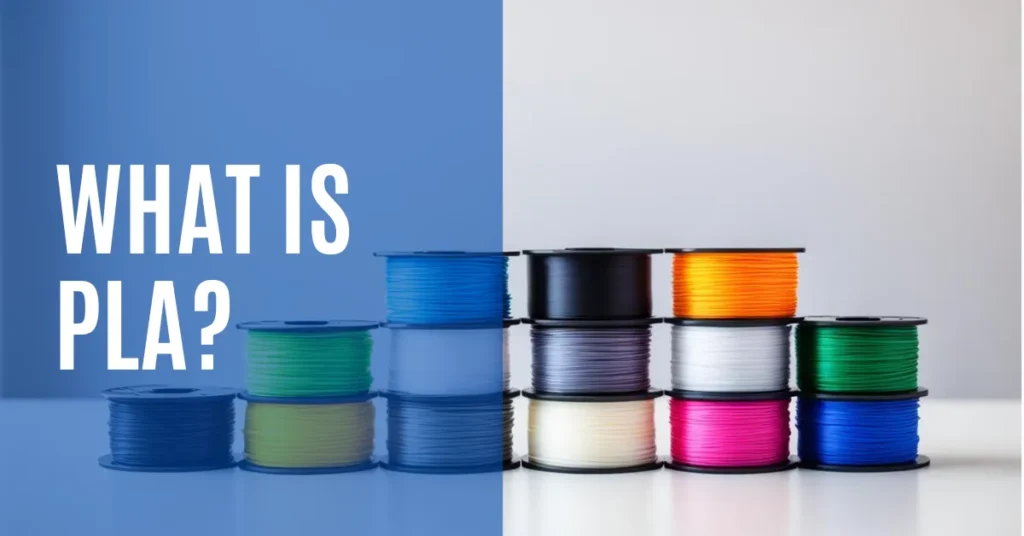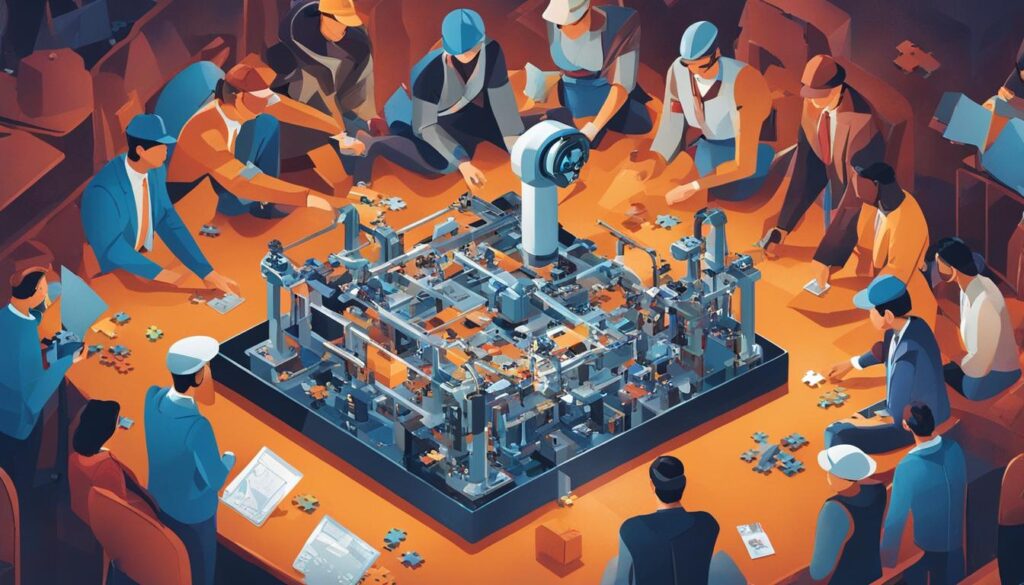What is PLA filament? How does it compare to other 3D printing filaments? And what makes it a popular choice for beginners? Explore the world of PLA filament and discover its material properties, benefits, and why it’s considered one of the best options for 3D printing enthusiasts.
Table of Contents
Key Takeaways
- PLA filament is a type of polyester made from fermented plant starch, offering biodegradability and eco-friendliness.
- It is easy to work with, making it a great choice for beginners in the 3D printing world.
- PLA has lower heat resistance compared to ABS, but it does not release fumes or odors during printing.
- With diverse blends and types available, PLA can mimic the properties of wood, metal, carbon fiber, and more.
- From food packaging to medical devices, PLA finds applications in various industries due to its biodegradability and recyclability.
PLA Filament Types and Characteristics
PLA filament, commonly used in 3D printing, comes in various types and blends, each with its own unique characteristics. Exploring the different PLA filament types allows for a diverse range of applications and customized printing results.
Wood Filaments
One popular type of PLA filament is wood filament, which combines PLA with natural wood fibers, such as bamboo or pine. This blending process gives the printed objects a distinctive wood-like appearance and texture while maintaining the ease of use and biodegradable nature of PLA filament.
Metal Filaments
PLA can also be mixed with metals like bronze or copper to create metal filaments. This blend provides the strength and metallic appearance required for certain specialized applications, such as jewelry or decorative objects. Metal filaments offer a cost-effective alternative to traditional metal printing methods.
Specialty Filaments
In addition to wood and metal, PLA can be blended with other materials to create specialty filaments. Carbon fiber filaments combine PLA with carbon fibers, resulting in enhanced stiffness and strength. Conductive carbon filaments mix PLA with conductive carbon particles, making them suitable for electronic applications.
Characteristics of PLA Filament
PLA filament possesses several distinct characteristics that make it a popular choice for 3D printing enthusiasts:
- Easy to Print With: PLA has excellent layer adhesion and does not require a heated print bed, making it easier to use, especially for beginners.
- No Emission of Fumes: Unlike ABS filament, PLA does not release harmful fumes or produce unpleasant odors during the printing process.
- Wide Color Range: PLA filaments are available in a vast array of vibrant colors, allowing for visually appealing and creative prints.
Production and Recycling of PLA
The production and recycling of Polylactic Acid (PLA) play a crucial role in its sustainability and environmental impact. Understanding the methods of PLA production and its end-of-life scenarios is essential for promoting responsible usage and disposal of this biodegradable polymer.
PLA production begins with the fermentation of sugars derived from plant-based materials such as corn or sugar cane. These sugars are converted into lactic acid through a biological process. The lactic acid is then polymerized to form PLA. This production method utilizes renewable resources and contributes to a reduced carbon footprint.
Once PLA products reach the end of their lifecycle, recycling becomes an important consideration. PLA can be recycled through both chemical and mechanical means. Chemical recycling involves depolymerization or transesterification, which breaks down the PLA into its monomers. These monomers can then be used to produce virgin PLA, reducing the need for new raw materials.
Mechanical recycling, on the other hand, involves the melting and reprocessing of PLA waste to create new PLA products. This method provides another avenue for reusing PLA and reducing waste. However, it is crucial to ensure proper sorting and separation of PLA waste to maintain the quality and integrity of the recycled material.
In addition to recycling, PLA can also be composted under industrial composting conditions. In these controlled environments, PLA breaks down into natural compounds, contributing to soil health. Composting PLA helps divert waste from landfills and promotes a circular economy.
If composting or recycling is not feasible, PLA products can be incinerated to generate energy. Incineration produces heat or electricity through the combustion of PLA, providing an alternative means of utilizing this biodegradable material.
However, it is important to note that landfill disposal is the least environmentally friendly option for PLA. Due to its slow degradation rate in ambient temperatures, PLA may persist in landfills for an extended period, contributing to environmental pollution.

Properties and Uses of PLA
PLA, or Polylactic Acid, possesses several properties that make it a versatile material suitable for various applications. It is known for its stiffness and relative strength, although it can be brittle and lacks flexibility. Notably, PLA has a low melting point, which makes it an excellent choice for 3D printing.
When it comes to 3D printing, PLA is widely used as a feedstock for desktop printers due to its ease of use and compatibility with low extrusion temperatures. Its low melting point allows for precise and efficient printing, resulting in detailed and accurate 3D models. Beginners often choose PLA as their filament of choice because it is readily available, requires less maintenance, and does not release unpleasant fumes during the printing process.
PLA finds application in various industries, including food and beverage packaging, medical devices, textiles, cosmetics, and prototyping. Due to its biodegradable nature, PLA is commonly used for disposable food and drink containers, offering a more sustainable alternative to traditional plastics. Its biocompatibility also makes it suitable for medical devices, such as surgical implants, sutures, and drug delivery systems.
Furthermore, PLA can be easily post-processed to achieve desired finishes. It can be sanded to smoothen rough surfaces, allowing for improved aesthetics. Additionally, PLA can be painted to add color or coated with protective finishes. These post-processing options make PLA an ideal choice for creating visually appealing and functional prototypes.
It is worth noting that PLA is derived from renewable resources, making it an environmentally friendly material. In addition to being biodegradable, PLA is compostable and recyclable, further contributing to its sustainability. Its eco-friendly properties have made PLA a popular choice among environmentally conscious individuals and industries.
To summarize, here are the key properties and uses of PLA:
- Stiffness and relative strength
- Low melting point, making it ideal for 3D printing
- Wide range of applications including food packaging, medical devices, textiles, cosmetics, and prototyping
- Ease of post-processing for achieving desired finishes
- Derived from renewable resources, biodegradable, compostable, and recyclable
Conclusion
PLA filament is a popular choice for 3D printing beginners due to its biodegradability and ease of use. Derived from renewable resources, PLA offers a wide range of applications and demonstrates its environmental benefits. Notably, PLA production is more energy-efficient and environmentally friendly compared to conventional plastics, making it an attractive option for sustainable manufacturing.
However, it’s important to consider PLA’s slow degradation rate in ambient temperatures and its end-of-life scenarios for ensuring environmental sustainability. Proper disposal methods such as industrial composting or incineration are crucial to mitigate any negative environmental impact. Recycling PLA through chemical or mechanical means also promotes a circular economy and reduces waste.
Despite its limitations in terms of heat resistance and strength compared to other plastics, PLA remains a versatile and widely used material in various industries. From food and beverage packaging to medical devices, textiles, cosmetics, and prototyping, PLA’s properties offer unique advantages. With its ease of printing and compatibility with low extrusion temperatures, PLA continues to be the filament of choice for many 3D printing applications.
In summary, PLA filament provides beginners with an accessible and environmentally friendly option for 3D printing. Its biodegradability and ease of use make it an attractive choice, while its renewable origins and energy efficiency contribute to a more sustainable production process. Despite the challenges of slow degradation and limited strength, PLA remains a versatile material with a wide range of applications in various industries. As we strive for greener and more sustainable alternatives, PLA filament continues to shape the future of 3D printing and manufacturing.
FAQ
What is PLA filament?
PLA filament is a type of polymer material used in 3D printing. It is made from fermented plant starch, such as corn or sugarcane, and is known for its biodegradability and ease of use.
What are the benefits of using PLA filament?
PLA filament is biodegradable, environmentally friendly, and derived from renewable resources. It is easy to print with, does not release fumes or bad odors, and is suitable for various applications, including food packaging and medical devices.
What are the characteristics of PLA filament?
PLA filament is stiff and relatively strong, but also brittle and lacks flexibility. It has a low melting point, making it ideal for 3D printing. PLA is available in different types and blends, including wood and metal filaments.
What is the difference between PLA filament and ABS filament?
PLA filament has lower heat resistance compared to ABS filament, making it unsuitable for certain applications like plastic cups for hot liquids. However, PLA is easier to print with and does not release toxic fumes.
What is PLA filament best used for?
PLA filament finds common uses in various fields, including medical and food-related applications. It is popular in 3D printing for desktop fused filament fabrication 3D printers due to its ease of post-processing—PLA can be easily sanded, painted, or otherwise manipulated. The material is versatile and can be processed by nearly all 3D printers.

